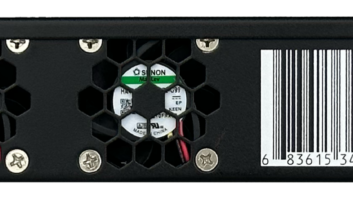I sensed a humbleness in Joel Spira that I didn’t expect from the inventor and developer of the solid-state electronic “dimming device” on the day that he donated materials related to his company’s 50-year history to the Smithsonian’s National Museum of American History. Somehow, I expected more ego from the chairman and founder of Lutron Electronics. Afterall, he truly has something to brag about.
Lutron Products Donated to the Smithsonian
1. The oldest Capri dimmer in our archives (circa 1964)
2. A Capri display from the 1960s
3. A Capri advertisement from the 1960s
4. Joel Spira’s “Notebook A”
5. Nova dimmer
6. RanaX dimmer and remote control
7. NeTwork system components
8. GRAFIK Eye
9. RadioRA system components
10. Vierti dimmer
11. Skylark eco-dim dimmer
12. Serena motorized window shading system
Instead I met an unassuming man who reminded me of my granddad (if my granddad had been an engineer/inventor) when he recounted fascinating anecdotes about his career and told amusing stories about a caveman named Ogg who, he joked, was the true inventor of the lighting dimmer when his wife asked him to roll a rock in front of their cave’s entrance to block the sun a little.
During a luncheon in a private room off the main lobby of the iconic Washington D.C. museum, Spira and his wife Ruth, officially donated an early version of the original solid-state (devices using transistors) Capri dimmer manufactured by Lutron in September 1964. Also part of the donation is a retail display featuring the fully functional dimmer and other Lutron dimmers and lighting-control systems that show lighting-control developments at the company over the past 50 years.

Smithsonian’s National Museum of American History director Brent D. Glass (right) with Lutron’s Joel Spira.
“It’s just tremendous; Ruthie and I were just so thrilled that what we did is really going down in history. And it’s a grand thing to show our children, our grandchildren,” Spira told me after the ceremony. “And it’s also for all of our early co-workers, the original leadership of John McKiernan, Ruthie and two other people who were not here, John Longenderfer, and one who passed away, Don Mershon.”
The museum requested objects and papers that would provide insight into Spira’s career as an inventor. The museum received his original inventor’s notebook with more than 100 pages of handwritten documentation and historic photographs, as well as product advertisements.


Part of the donation is a retail display featuring the fully functional dimmer and other Lutron dimmers and lighting-control systems that show lighting-control developments at the company over the past 50 years.The museum also received Spira’s original inventor’s notebook.
Pressed to single out his favorite product or technological creation, Spira said that his favorite innovation has always been the last one he did. “You always think, ‘well this is the greatest thing I ever did,’” he said. “Some become greater than others, but that’s history. Whatever is the latest thing is what it’s all about for me.”
The Lutron materials will join other artifacts in the museum’s Electricity Collection, including experimental lightbulbs from Thomas Edison, dimming light sockets from the 1910s, theatrical lighting controls from the 1920s, and many types of light switches. The artifacts, as they are now referred to by the museum, will not go on public display immediately, but will be available to researchers as part of a permanent collection.
Despite now finding his life’s work’s positioned right next to Edison’s, Spira’s not one to seek the limelight much himself. It’s the engineer’s personality, he says, that has kept him mostly in the shadows, until now. “In their office, engineers put their desks against the wall and look into the wall,” Spira said. “Most of us are a little introverted. Everybody told me I’m going to enjoy this, so I’m going to enjoy it.”
According to Lutron, Spira developed a way to reduce the light output of an incandescent bulb in his New York apartment in the late 1950s, which extended the life of the lightbulb and saved electrical energy. The commercialization of the solid-state dimmer has made such control of interior lights affordable for most homes. Lutron was founded in 1961.
“As the nation’s history museum we tell the story of this country in all its depth and breadth,” said Brent D. Glass, director of the museum. “Collections such as this one from Lutron help us to understand the continuation of the electrical evolution, the process of invention and the history of business and manufacture.”
And although many of his products are considered historical artifacts now, Spira keeps working and moving forward, not looking back. “I should be retired; I should be dead, but I’m not,” he said with a little laugh. “This is still fun. I’m always looking to find out new things. I’m always reading technical journals and I’m involved with many universities on their advisory committees and such. I always wanted to be an engineer, and I did. It’s just fun.”
For highlights of the event, check out this short video montage:






